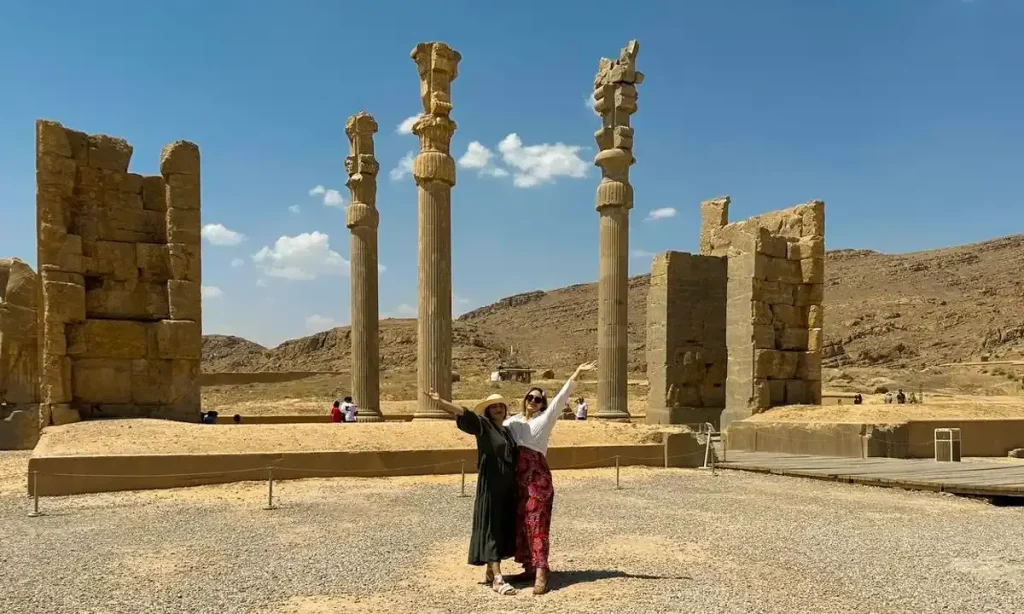Discover the wonders of Iran’s historical places, where each site tells a story of civilizations past. This guide not only points you to Iran’s most cherished ruins, palaces, and landmarks but also enriches your understanding of the country’s rich cultural heritage with detailed historical contexts and visitor information. From the majestic ruins of Persepolis, where kings of old held court, to the bustling bazaars of Isfahan, lined with intricate Islamic architecture, each location offers a unique glimpse into the history that has shaped Iran. This journey through time will help you appreciate the artistic achievements and historical significance of these storied places, making your visit more meaningful and insightful.
Top Iran historical places are:
- Persepolis
- Naqsh-e Jahan Square (Imam Square)
- Golestan Palace
- Nasir al-Mulk Mosque (Pink Mosque)
- Ali Qapu Palace
- Jameh Mosque of Isfahan
- Pasargadae
- Soltaniyeh Dome
- Bisotun Inscription
- Chogha Zanbil
How Iran's Rich History Shapes Modern Culture
Iran’s history is a tapestry woven with the threads of ancient empires, profound cultural exchanges, and enduring artistic expressions. From the powerful dynasties of the Achaemenids to the intellectual richness of the Islamic Golden Age, each era has contributed uniquely to the modern Iranian identity. This historical legacy is evident in Iran’s modern culture through its language, which carries elements of ancient Persian, its national celebrations like Nowruz (the Persian New Year), and its architectural landscapes that blend ancient styles with modern needs. Additionally, traditional Persian arts, such as carpet weaving, poetry, and music, continue to influence contemporary artistic expressions, making Iran’s historical presence a vibrant and integral part of its modern culture.
An Introduction to Iran's Historical Sites
Explore the essence of Iran’s top historical sites, where centuries-old narratives and architectural marvels offer a captivating glimpse into the nation’s storied past. Each location stands as a testament to the profound events and cultural flourishes that have shaped the identity of modern Iran.
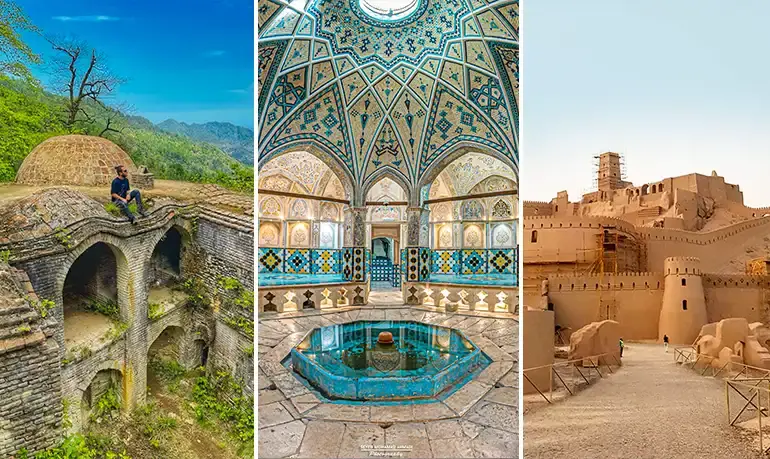
Persepolis: A Monumental Legacy of Ancient Persia
Persepolis, known as “The City of Persians,” was the ceremonial capital of the Achaemenid Empire, founded by Darius I in 518 BCE. Situated in the Fars Province of modern-day Iran, it epitomizes the wealth, power, and cultural depth of ancient Persia. Serving primarily as a site for the spectacular Nowruz (Persian New Year) celebrations, it symbolized the empire’s unity and glory. The city was designed to impress visitors and dignitaries with its grandeur and exquisite craftsmanship, reflecting the empire’s ideal of multiculturalism by incorporating elements from all the regions it governed.
Visiting Persepolis today, one can walk through the ruins and imagine the splendor of the ceremonies that once took place within its boundaries. It stands as a testimony to the architectural and cultural achievements of ancient Persia, enduring as one of the most important archaeological sites in the world.
Key Attractions
- The Gate of All Nations: This grand entrance to the Persepolis complex, built by Xerxes I, served as a welcoming point for delegates from all parts of the empire. Flanked by colossal bull-headed statues, the gate was intended to convey the might and grandiosity of the Persian Empire.
- Apadana Palace: The most magnificent of the structures at Persepolis, the Apadana was primarily used by the King of Kings to receive guests and celebrate Nowruz. Its vast hall was supported by seventy-two columns, each standing 24 meters high, and adorned with detailed reliefs that depict scenes of tribute bearers from diverse nations bringing gifts to the Persian king, showcasing the empire’s vast reach.
- The Tomb of Artaxerxes III: Although less visited compared to the other royal tombs, the tomb of Artaxerxes III is part of the necropolis Naqsh-e Rostam, located a few kilometers from Persepolis. The tomb, carved into a cliff face, features a façade with a representation of the king before a fire altar, signifying the Zoroastrian religious practices of the time.
Cultural Impact
Persepolis remains a potent symbol of Persian cultural identity and national pride. It was tragically burned by Alexander the Great’s army in 330 BCE, an act often considered a grievous loss to cultural heritage. Today, the site serves as a profound reminder of ancient ingenuity and Persian artistic achievement. Excavations and preservation efforts at Persepolis continue to offer insights into Achaemenid architecture, imperial ideology, and the artistic traditions that influenced later periods of Persian history.
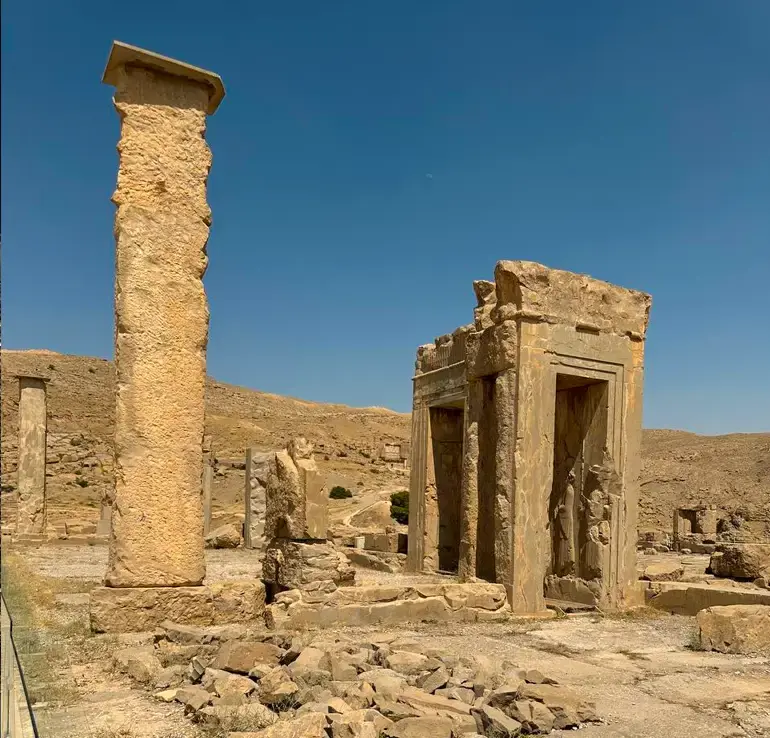
Naqsh-e Jahan Square: Safavid Architectural Triumph
Naqsh-e Jahan Square, also known as Imam Square, is situated at the center of Isfahan, Iran. Constructed between 1598 and 1629 during the reign of Shah Abbas I, the square symbolizes the pinnacle of Safavid architectural and urban planning achievement. Its establishment marked the consolidation of Shah Abbas’s capital in Isfahan and served as a key component of his larger agenda to elevate the Safavid Empire’s stature within the region and across the world. The square was designed to showcase the glory of the empire, and it became a central hub for commercial, religious, and royal ceremonies, intertwining the threads of the Safavid socio-political and religious life.
Today, Naqsh-e Jahan Square remains a focal point for cultural gatherings, public events, and national celebrations. It serves as a living museum of Persian architecture and a window into the soul of Iran during the Safavid era. Visitors to the square are treated not only to its architectural beauty but also to the lively atmosphere of the bazaars and public spaces that continue to thrive around it.
Key Attractions
- Imam Mosque (Shah Mosque): Positioned at the south end of the square, the Imam Mosque is a stunning example of Islamic architecture under the Safavids, known for its magnificent portal, towering minarets, and expansive courtyard. The mosque’s design and decoration employ an abundance of blue tiles and intricate calligraphy that captures Islamic artistry, making it a symbol of the Islamic world’s splendor. The mosque was intended as a visual statement of the Safavid dynasty’s might and piety.
- Ali Qapu Palace: Directly opposite the mosque on the west side of the square, Ali Qapu Palace functioned as the royal residence and seat of government. The six-story palace is famed for its elevated terrace that features 18 slender columns, offering Shah Abbas and his guests a panoramic view of the square’s grandeur and the bustling activities below. The upper floors contain the renowned Music Room, adorned with intricate stucco work designed to enhance the acoustics of musical performances.
- Sheikh Lotfollah Mosque: Located on the eastern side of the square, this mosque differs from the Imam Mosque in its purpose and design, as it was built primarily for the royal family’s use. Unlike other mosques, it lacks a minaret or courtyard, which underscores its private nature. The dome changes color from dawn to dusk, moving through shades of cream to pink, which is reflected in the exquisite tile work that decorates the exterior and interior of the building.
Cultural Impact
Naqsh-e Jahan Square remains one of the largest city squares in the world and is a prime example of Iranian and Islamic architecture. The layout of the square, surrounded by buildings from the Safavid era, captures a significant historical and cultural epoch, reflecting the ambitious urban aesthetic and planning of the Safavid dynasty. In 1979, the square was designated a UNESCO World Heritage Site, recognized for its outstanding testimony to the level of craftsmanship and the artistry of Persian architecture.
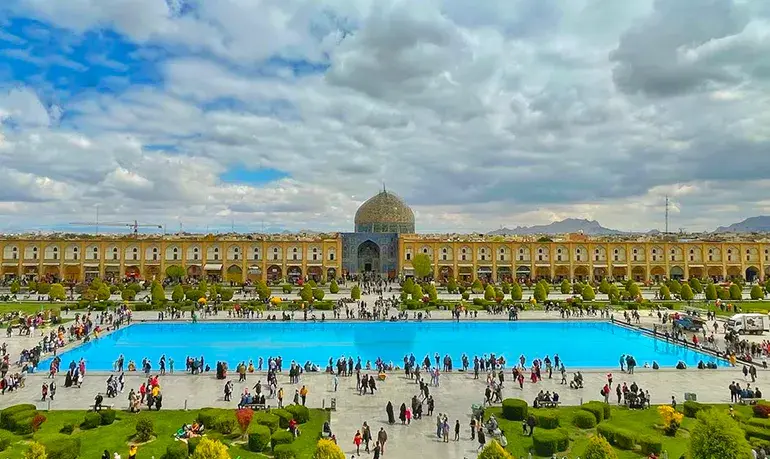
Golestan Palace: A Quintessential Emblem of Qajar Opulence
Golestan Palace, located in the heart of Tehran, Iran, is one of the oldest historic monuments in the city, dating back to the Safavid era. However, it gained prominence and underwent significant expansions and renovations during the Qajar dynasty, particularly under the rule of Nasser al-Din Shah in the 19th century. The palace complex served as the official residence and the administrative seat of the Qajar royal family and became a center of Qajar arts and politics. This period mark a significant era in Persian history, with Golestan Palace at its core, symbolizing the cultural and artistic renaissance that defined the Qajar rule. Here, the royal ceremonies, formal receptions, and significant state events were held, reflecting the Qajar monarchy’s political status and aesthetic preferences.
Highlights of Architectural and Artistic Elements
- Marble Throne (Takht-e Marmar): One of the standout features of Golestan Palace is the Marble Throne Veranda, built-in 1806 by Fath-Ali Shah Qajar. The throne is made of sixty-five pieces of yellow marble and is set within an intricately decorated, open-fronted pavilion, adorned with paintings, marble carvings, tilework, woodwork, and inlaid mirror work. This throne was used for coronation ceremonies and is an exemplar of Persian craftsmanship.
- Shams ol Emareh (Edifice of the Sun): Constructed under Nasser al-Din Shah’s rule, this striking building is notable for its European-inspired architecture, which marked a departure from traditional Persian architectural styles. Standing as one of the tallest buildings of its time, the Shams ol Emareh showcases elaborate brickwork and decorative balconies, reflecting the Qajar fascination with European styles and innovations.
- Mirror Hall (Talar-e Aineh): Arguably the most famous hall within the palace, the Mirror Hall is an outstanding example of Iranian interior design, featuring walls and ceilings entirely covered with pieces of mirror interlaced with intricate paintings. This room exemplifies the artistic technique called “Aineh-Kari,” which became very popular during the Qajar era.
- Khalvat-e Karim Khani: Originally built as part of the residence of Karim Khan Zand, this nook turned into a favorite retreat for Nasser al-Din Shah, who sought solitude away from the hustle and bustle of palace life. It features simple but elegant decorations and a small pool, contrasting with the otherwise opulent decor of the palace.
Cultural Impact
Golestan Palace not only served as a nexus of power and royal authority during the Qajar dynasty but also as a beacon of cultural and artistic progression. The amalgamation of Persian arts with Western influences at the palace marked a period of significant cultural exchange and adaptation. Today, the palace is a UNESCO World Heritage site, attracting visitors worldwide to admire its historical richness and architectural splendor. It stands not only as a testament to the legacy of the Qajar era but also as an invaluable piece of Iran’s cultural heritage.
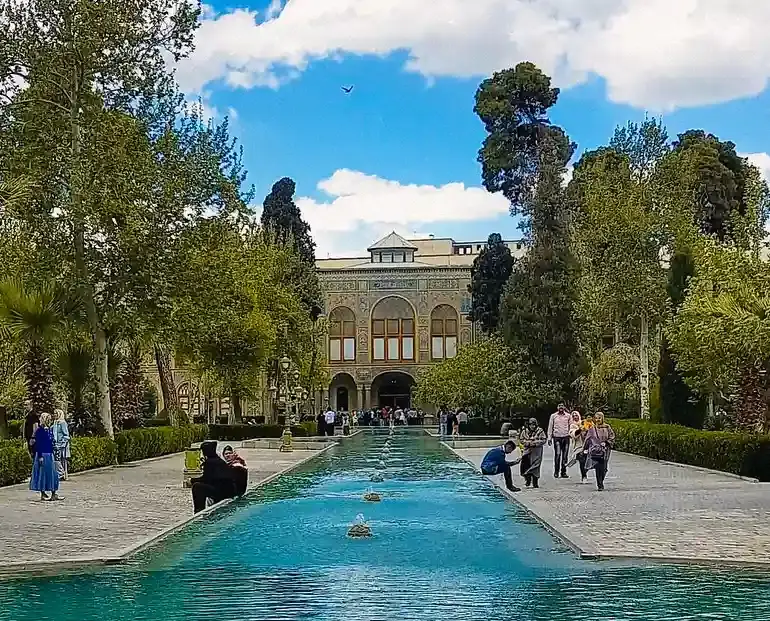
Nasir al-Mulk Mosque: A Kaleidoscope of Colors and Light
Nasir al-Mulk Mosque, also known as the Pink Mosque, is located in Shiraz, Iran. It was completed in 1888 during the Qajar dynasty by the order of Mirza Hasan Ali Nasir al Mulk. This mosque stands out for its stunning incorporation of colorful glass, intricate tiles, and traditional Islamic architecture, making it one of the most beautiful and photographed mosques in Iran.
Unique Design and Color Play
The distinctive feature of Nasir al-Mulk Mosque is its extensive use of stained glass on the façade and the sides of its winter prayer hall. The interior is an explosion of color, particularly when morning light passes through the stained glass and casts vibrant hues onto the intricately woven Persian carpets, finely painted tiles, and ceilings. The design also includes traditional elements such as arches, niches, and extensive muqarnas—a type of decorative corbel used in Islamic architecture—creating a sense of both grandeur and intricate detail.
Photography Tips
The best time to visit Nasir al-Mulk Mosque for photography is early in the morning, just after sunrise. This is when the light filters through the stained glass and illuminates the interior with a kaleidoscope of colors. Photographers are advised to bring a tripod to capture the changing light without blur. The light and colors change rapidly, so multiple visits at different times can yield a range of photographs.
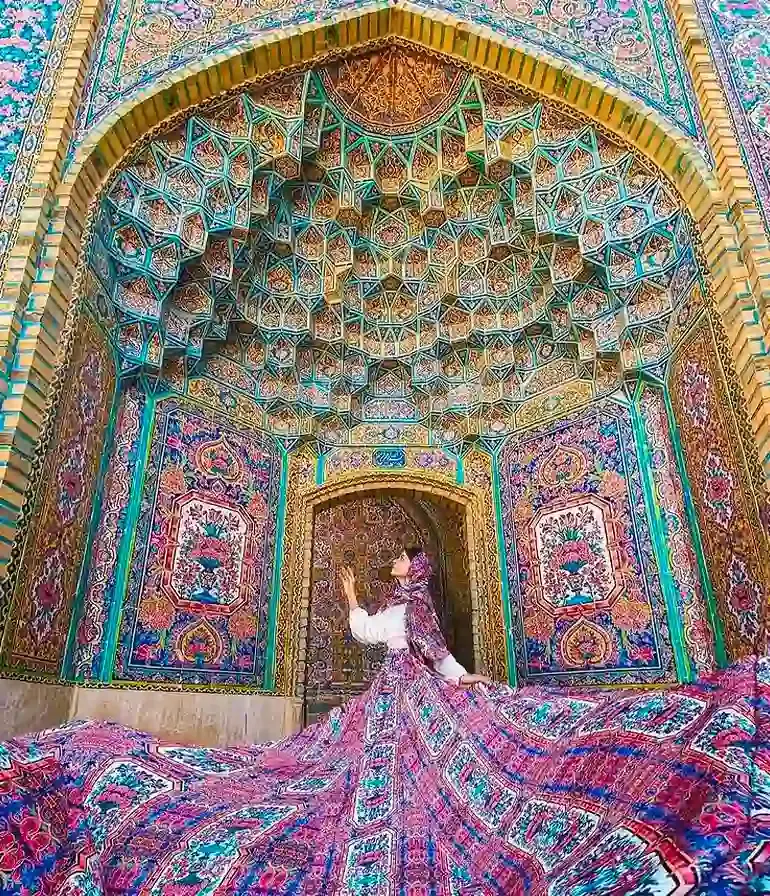
Ali Qapu Palace: A Portal to Safavid Grandeur
Ali Qapu Palace dominates the western side of Naqsh-e Jahan Square in Isfahan, Iran. Built at the very end of the 16th century as a residence and reception hall under Shah Abbas I, the palace served as a monumental gateway to the administrative and governmental quarters of the Safavid capital. Its name, which means “Great Gate,” reflects its role as a gateway, not just in a physical sense but also as a portal to the might and sophistication of Safavid Iran. Ali Qapu Palace is a key historical sites that offer deep insights into the aesthetic and cultural values of their respective eras in Iranian history. Visiting these sites provides a vivid glimpse into the past, showcasing the art, architecture, and cultural achievements of Iran.
Architectural and Historical Importance
Ali Qapu is renowned for its architectural innovations and the aesthetic qualities typical of Safavid palaces. It is particularly notable for its height, six floors tall, unusual for Persian buildings of the time. The front façade features a wide terrace, supported by wooden columns, that overlooks the square, providing a perfect viewing platform for the many spectacles and polo games held there.
Special Rooms: The Music Hall
The Music Hall, or Talar-e Musique, situated on the sixth floor of the palace, is among its most famous features. This room is an architectural and acoustic marvel designed specifically for musical performances. The ceiling and walls are intricately inlaid with fine cut-outs that resemble the shapes of vases and other household utensils, which are believed to enhance the room’s acoustics. These designs were not only functional, helping to diffuse the music throughout the hall, but also added a layer of artistic expression to the room.
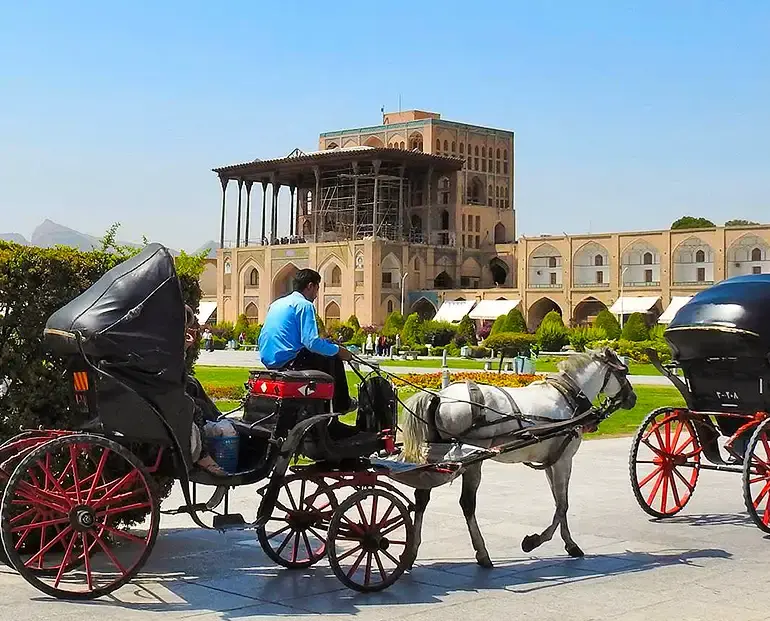
Jameh Mosque of Isfahan
The Jameh Mosque of Isfahan, also known as the Friday Mosque, stands as a monumental reflection of the architectural evolution over several centuries, beginning its life in the 8th century. It is one of the oldest mosques still standing in Iran and has been continuously added to and modified by successive Iranian dynasties, each adding its flavor while respecting the site’s historical integrity. This mosque is a comprehensive display of Persian architecture and Islamic art, evolving from the Abbasid era through the Seljuk, Ilkhanid, and Safavid periods.
Architectural Styles and Evolution
Originally a small structure, the mosque was expanded into a vast complex with four iwans (vaulted open rooms) and a courtyard. Over the centuries, it transformed into a stunning architectural piece with multiple rebuilds and renovations that incorporated various styles, from the austere Abbasid brickwork to the dazzling Seljuk tilework and the refined Safavid stucco decorations. This mosque effectively serves as a living museum, showcasing the development of both Islamic architecture and Persian art over more than a millennium.
Notable Features
- Stucco Decorations: The mosque features exquisite stucco work, especially from the Seljuk period, presenting Islamic calligraphy and arabesque patterns in high relief on walls and domes.
- Tile Work: The tile work, particularly evident in the later constructions, displays intricate geometric and floral designs, contributing vibrant color and artistic detail.
- Central Dome: One of the architectural highlights is the central dome, which was reconstructed in the 11th century. It is an engineering marvel of its time, featuring intricate brickwork and a distinctive blue tile exterior that symbolizes the Islamic sky.
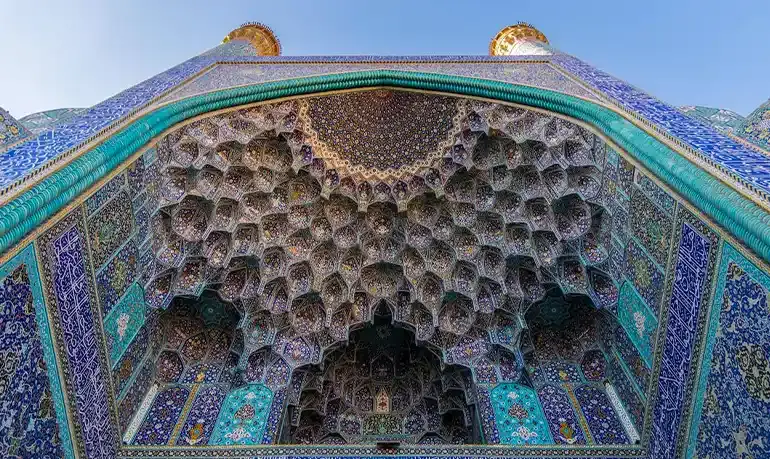
Pasargadae: Birthplace of the Persian Empire
Pasargadae holds profound historical significance as the first capital of the Achaemenid Empire under Cyrus the Great. Founded in the 6th century BCE, it symbolizes the birth of the Persian Empire and showcases the early Achaemenid style of architecture and urban planning. Pasargadae represents a crucial period in Iranian history, embodying the ideals and ambitions of Cyrus the Great, including his concepts of governance and the architectural manifestation of his rule.
Key Sites to Visit
- Tomb of Cyrus the Great: The most iconic feature of Pasargadae, the Tomb of Cyrus, stands as a simple but grand structure, reflecting the Zoroastrian tradition of burial monuments. It features a gabled stone roof and a raised platform, resembling a modest yet regal resting place for the founder of the Persian Empire.
- The Fortress of Toll-e Takht: Situated on a nearby hill, this fortified complex overlooks the palace area and serves as a strategic and administrative center. The fortress contains significant defensive walls and terraces that highlight the military aspects of the early Persian empire’s planning capabilities.
Visiting Pasargadae offers a unique insight into the formative period of Persian imperial history, allowing visitors to walk through the remnants of a world that laid the foundations for modern Iran.
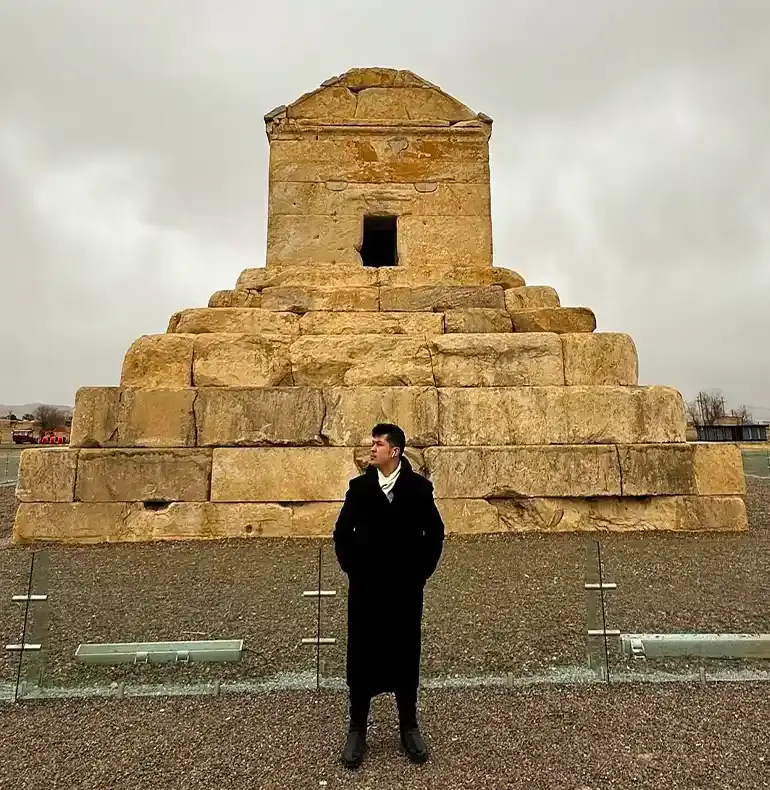
Bisotun Inscription: A Key to Ancient Scripts
The Bisotun Inscription is monumental in the history of writing and archaeology, particularly for its role in deciphering the cuneiform script. Located on Mount Bisotun in the Kermanshah Province of Iran, this inscription dates back to the 6th century BCE during the reign of Darius the Great. It was crucial in unlocking the language of the Babylonians, as it included trilingual versions of the same text in Old Persian, Elamite, and Babylonian (Akkadian). This facilitated the comparative translation efforts in the 19th century that ultimately led to the understanding of the cuneiform script, providing a gateway to ancient Mesopotamian history and culture.
Overview of the Site’s Carvings and Their Historical Context
The inscription itself is an extensive limestone rock relief panel featuring a large image of King Darius holding a bow, a symbol of kingship, and trampling a rebel. Nine figures stand before him, representing the conquered peoples. The text details Darius’s victories in a propagandistic narrative, intended to communicate his legitimacy and divine support across his vast empire. The relief and text are remarkably well-preserved, offering insight into the political and social dynamics of the Achaemenid Empire.
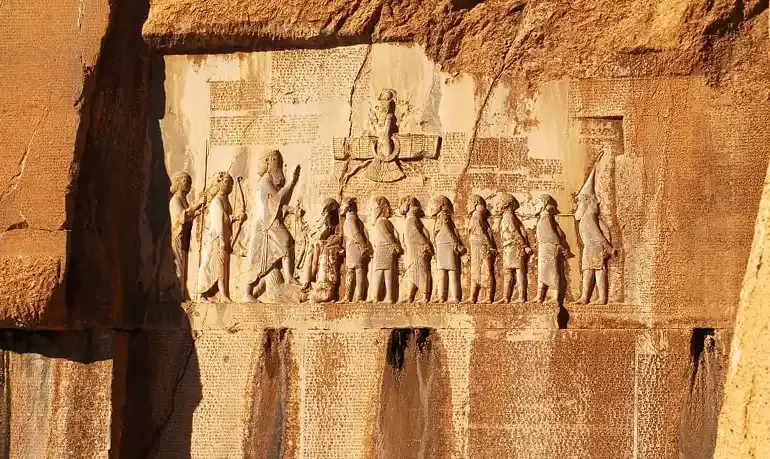
Chogha Zanbil: An Ancient Elamite Sanctuary
Religious Significance of the Ziggurat in Ancient Elam
Chogha Zanbil, located near Susa in Khuzestan province of Iran, is home to one of the few ziggurats outside of Mesopotamia. Built around 1250 BCE by the Elamite king Untash-Napirisha, the ziggurat was part of a religious complex dedicated to Inshushinak, the chief god of the Elamites. This temple complex served not only as a place of worship but also as a center for the political and social activities of the Elamite kingdom, highlighting the interconnectedness of religious and temporal authority in ancient Elam.
Preservation Status and What to Look for When Visiting
Chogha Zanbil is remarkably well-preserved for its age, partly because it was buried under sand until its rediscovery in the 1930s. The site includes the remains of the original ziggurat, temples, and three palaces, laid out in three concentric circles, which demonstrate the urban planning and religious devotion of its builders. Visitors can observe the ziggurat’s unique construction with its original baked bricks, some of which bear Elamite inscriptions. These inscriptions and the site’s layout provide valuable insights into the architectural and religious practices of ancient Elam. The UNESCO World Heritage status of Chogha Zanbil helps ensure ongoing preservation efforts and provides visitors a glimpse into a seldom-seen civilization that once flourished in the region.
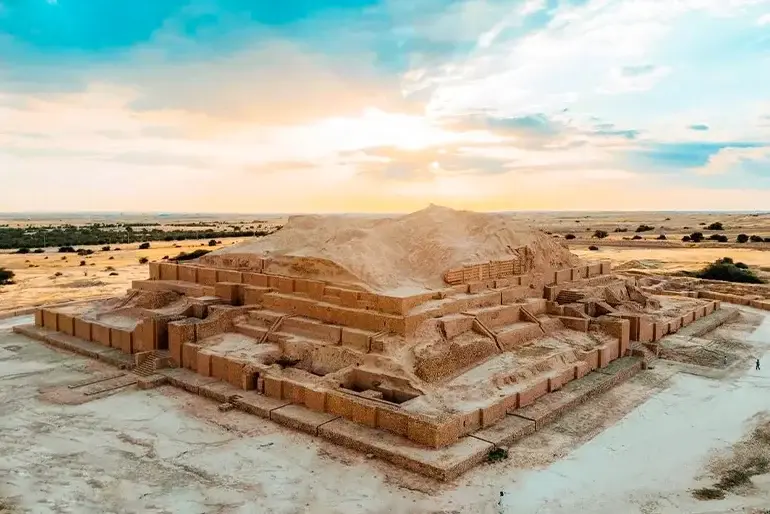
Soltaniyeh Dome: A Marvel of Ilkhanid Architecture
The Soltaniyeh Dome, located in the Zanjan province of Iran, stands as one of the most significant examples of Persian architecture and is particularly noted for its architectural innovations during the Ilkhanid period. Built-in the early 14th century under the auspices of the Ilkhanid ruler Oljeitu, the dome was originally conceived as part of a larger complex intended to serve as a mausoleum for the Mongol rulers of Persia.
The dome’s design is a testament to the synthesis of various cultural influences, including Persian, Mongol, and Islamic. It is one of the largest brick domes in the world, standing at approximately 50 meters high, and is the earliest example of a double-shell dome in Iran. This architectural technique involves an inner and outer shell, providing not only structural stability but also thermal insulation. The dome is also notable for its intricate mosaic faience work and the stunning use of blue tiles that decorate the exterior, setting a precedent for later Islamic architecture.
UNESCO World Heritage Status
The Soltaniyeh Dome was designated a UNESCO World Heritage Site in 2005, recognized for its outstanding universal value as a masterpiece of human creative genius. The UNESCO recognition emphasizes the dome’s significant role in the development of Islamic architecture in central and western Asia, influencing later developments in dome-building technology and architectural decoration. The site’s World Heritage status ensures that efforts are made to preserve and protect the dome, allowing it to serve as a valuable educational and cultural resource for future generations.
The Soltaniyeh Dome not only embodies the architectural achievements of its time but also illustrates the historical and cultural interchange on the Silk Roads, marking it as a crucial monument in the study and appreciation of Islamic and Mongol heritage.
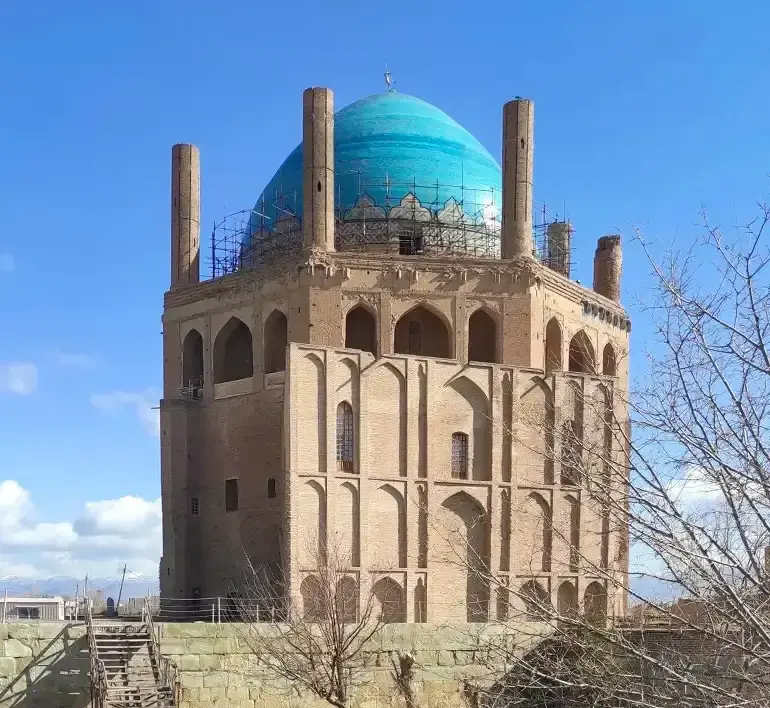
Last Word
Exploring Iran’s historical sites offers more than just a visual feast; it provides a deep connection to the past. Sites like Persepolis and the Nasir al-Mulk Mosque not only showcase architectural and cultural achievements but also immerse visitors in the rich tapestry of Iran’s history. Preserving these sites is vital for education and inspiration. Understanding our history is essential—it teaches us about humanity’s achievements and challenges, offering insights into our ancestors’ lives. By maintaining these historical treasures, we ensure that their stories continue to enrich and inform future generations, helping us understand our world and our place within it.
Navigating Iran: Essential Travel Tips for a Memorable Journey
- Cultural Etiquette
When traveling in Iran, respecting local customs and etiquette is crucial. Dress conservatively, particularly in religious sites; women should wear a headscarf and avoid tight-fitting clothing, while men should opt for long sleeves and trousers. Always use formal greetings, and be prepared to engage in friendly conversation. Hospitality is a cornerstone of Iranian culture, so be gracious if locals invite you for tea or a meal.
- Local Guides and Transportation
Employing a local guide can enhance your experience significantly. Guides not only provide insights into the historical and cultural context of the sites you visit but also help navigate language barriers and logistical challenges. For transportation, consider domestic flights for long distances, as Iran is a large country. For shorter trips, buses and trains are reliable and affordable options. In cities, taxis are plentiful and reasonably priced, but make sure to agree on the fare in advance or insist on using the meter.
- Accommodation
Iran offers a range of accommodations, from luxurious hotels in major cities like Tehran and Shiraz to more traditional options like guesthouses (known as mosaferkhaneh) that offer a more authentic experience. Booking ahead is advisable, especially during peak travel seasons such as the Nowruz (Persian New Year) holidays. For a unique experience, consider staying in a caravanserai, a historic inn that has been restored for modern travelers.
By following these tips, you can ensure a smooth and culturally respectful journey through Iran, making your visit both enjoyable and enriching.
